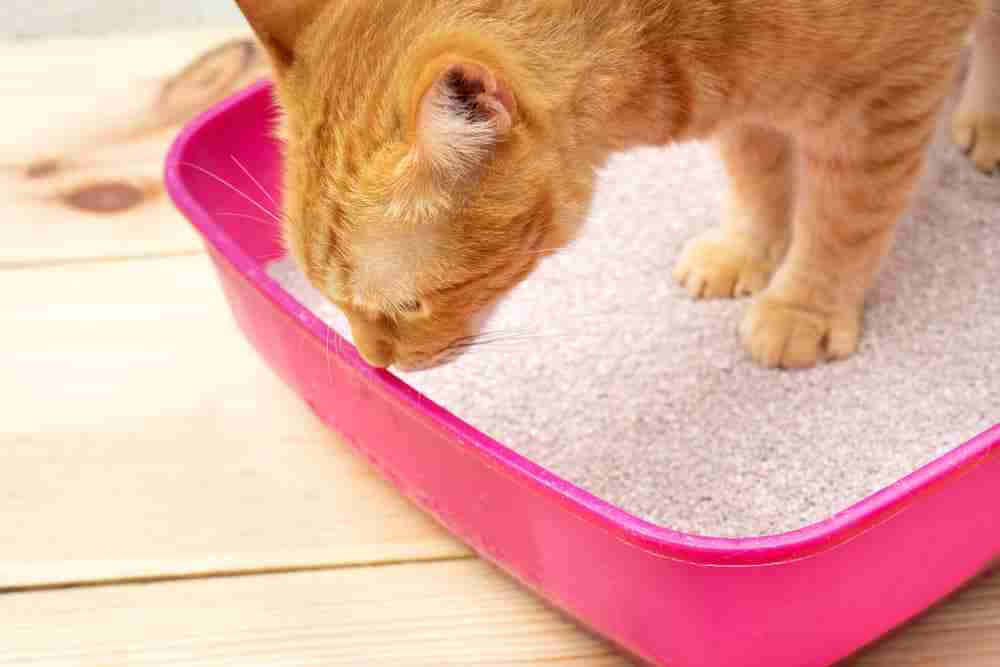Can a cat be allergic to litter? Yes, dust, clays, and fragrances can all trigger allergic reactions in cats. Read on to learn more…
Does changing out the litter box result in a sneezing fit? It’s probably not surprising to discover that plenty of people have allergies to cat litter.
What is surprising is that some cats are allergic to litter, just like their owners. If you see your cat sniffling after a session in the litter box, they might have allergies.
Litter allergies in cats are a somewhat common occurrence and nothing life-threatening to your kitty. To give your cat a comfortable lifestyle, you’ll need to switch litter products or brands.
This post looks at everything you need to know about cat allergies to litter. We’ll look at how to identify the symptoms of litter allergies. We’ll also examine how to stop them from showing up in your cat.

Why Is My Cat Allergic to Litter?
When your cat decides it’s time for a bathroom break, they head to the litter box. From the moment the kitty steps into the box, the paws contact the litter until they step out. After finding the right spot in the box, your kitty starts digging, pushing fine litter particles into the air.
After doing its business, your cat buries its trophy, kicking up more particles into the air. The fine litter dust lands on their coat, and they breathe it in while they’re sitting in the litterbox. Overexposure to litter dust is the primary cause of a cat litter allergy.
The direct contact and inhalation of litter dust is the mechanism allowing for the development of cat allergies. However, the secondary cause of litter allergies is the ingredients in the litter itself.
Manufacturers use cheap substrates like clay as the primary ingredient in cat litter. One of these clays, “sodium bentonite,” is a popular additive in many brands.
While sodium bentonite has excellent moisture-absorbing properties that initiate clumping, they also contain silica. Silica is the compound responsible for creating litter allergies in your cat. During the manufacturing process, the alteration to the clay creates “silica dust” from the material.
Silica is a well-studied respiratory irritant in people and pets. The particles are light and hang in the air for several seconds, depending on the ventilation around the litter box. If your cat’s litter box is in an unventilated area, consider moving it to allow air to circulate when your cat is digging.
In some cases, the fragrances added to litter cause litter allergies in cats. If you’re using a scented brand, try switching to unscented and see if it makes a difference in your cat’s allergies.
The severity of your cat’s allergic reaction to litter depends on the type of litter causing the response and the exposure time.

While clay-based products are the most common source of cat litter allergies, some cats develop them with natural products as well. If your kitty has environmental allergies, they’ll also experience allergic reactions to natural products.
What are the Common Cat Litter Allergy Symptoms?
If your cat has allergies to litter, they typically occur as skin or respiratory problems. Owners with cats that suffer from respiratory ailments or environmental allergies have a higher risk of developing litter allergies.
If your cat has a litter allergy, you’ll notice the following symptoms occur shortly after finishing in their litter box.
- Itchy and watery eyes.
- Sneezing, sometimes for several minutes.
- A runny nose.
- Irritated, red eyes.
- Itching skin causing excessive scratching and cat scooting.
- Swelling in the face.
- Hives or blisters, and occasionally acne development.
- The development of a cough or wheezing.
If your cat develops litter allergies, you need to identify them and take action right away. Continued exposure to the irritants in the litter exacerbates the cat’s allergy symptoms. As a result of overexposure, the reaction’s severity increases, and your cat exhibits symptoms for longer.
Some owners might notice that the cat’s allergies only start appearing in the time they are around the litter box, fading shortly after moving away from it. If that’s the case, check that the ventilation around the box is adequate to reduce airborne particles from hanging around.
Some cats like to start grooming after stepping out of the box, and they start licking the litter particles off their fur while breathing in dust suspended in the air.

On occasion, there might be several factors influencing your cat’s litter allergies. It’s challenging for owners and vets to diagnose, and the only real way to know if it’s an allergy is to swap out the litter for another product.
Check the labels of your cat litter, and look for silica-free brands to avoid allergies to the compound. If that doesn’t work, consider switching to a natural litter brand featuring environmental materials. If the symptoms persist, take your cat to the vet for diagnosis.
Diagnosing Litter Allergies in Cats
If you have no luck with changing out the litter, it’s time to take your kitty to the vet. If the swaps fail, chances are your cat might have an environmental allergy. Book a consolation with your vet, and take your cat in your cat backpack to the vet.
Bring along a sample of your cat litter, and take a photo of the ingredients list on the bag before going to your appointment.
The vet analyzes the cat litter and gives your cat a thorough checkup. If they determine your cat has environmental allergies, the vet issues a prescription for medication to prevent allergy attacks.
It’s important to note that environmental allergies are difficult to nail-down, and it might take several visits to the vet for them to complete a successful diagnosis and treatment.
If the vet struggles to identify the cause, they may issue a blood test to examine markers in your cat’s blood work for answers.
Your vet might also use elimination strategies, changing one element in your cat’s life at a time. For instance, they’ll start with getting you to change the litter, and then their food, and so-on until you see a reduction in the allergic response in your kitty.
Keep Your Kitty Away from Allergens
Changing the litter to an allergy free cat litter product or brand is always the first step in resolving allergies in cats. Before you rush off to the vet and spend a fortune on checkups and blood work, start with this simple fix instead.
Check the ingredients on the label, and make sure you’re using a silica-free brand. Most manufacturers advertise silica-free blends on the packaging. You might have to pay a little more for the littler, but it resolves the allergy issues, and it lasts longer between changes.
Keeping your cat away from allergens is the best strategy after changing out the litter. We recommend following these tips for keeping your kitty allergy-free.
- Change the litter frequently.
- Keep the litter box in an airy, well-ventilated area.
- Make sure you’re using a silica-free product from a reputable brand.
- Avoid cheap litter as it’s packed with sodium bentonite.
- If your cat experiences allergies, change the litter product before taking them to the vet.
- If the allergies persist, book a consultation at the vet.
- Remember to take a photo of the ingredients listing in the litter.
Complications with allergies in cats aren’t common. Typically, changing litter to a different product or brand resolves the problem immediately.
However, if your cat doesn’t respond to this post’s recommendations, book an appointment with your vet.
